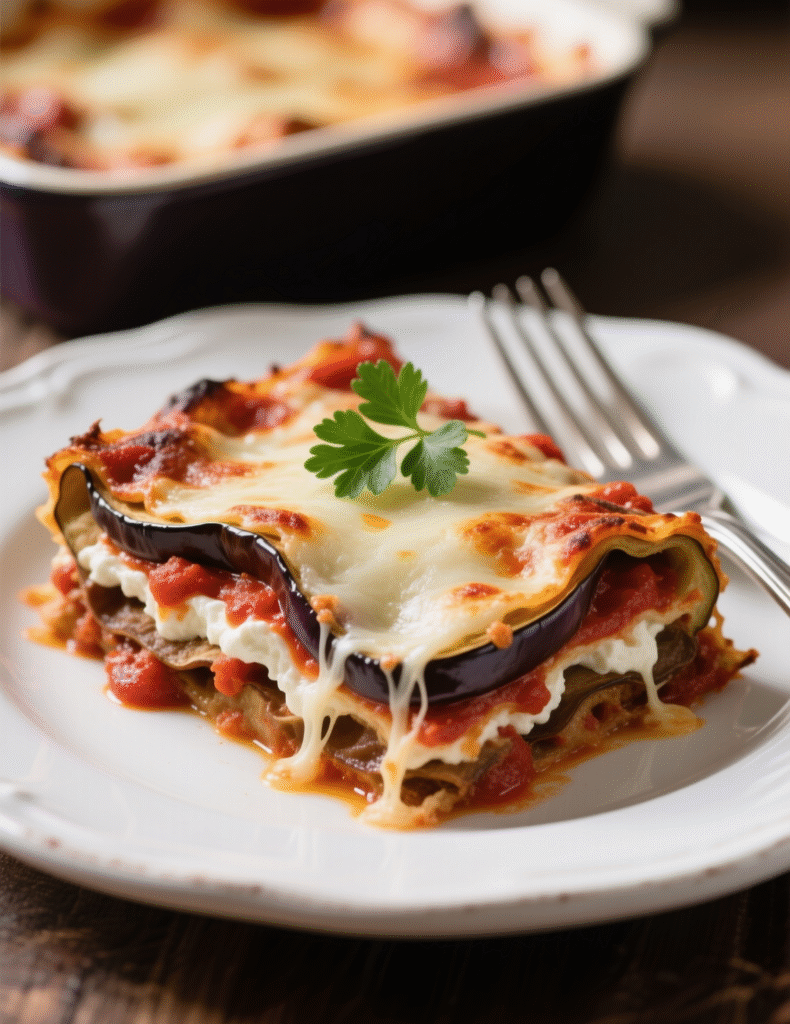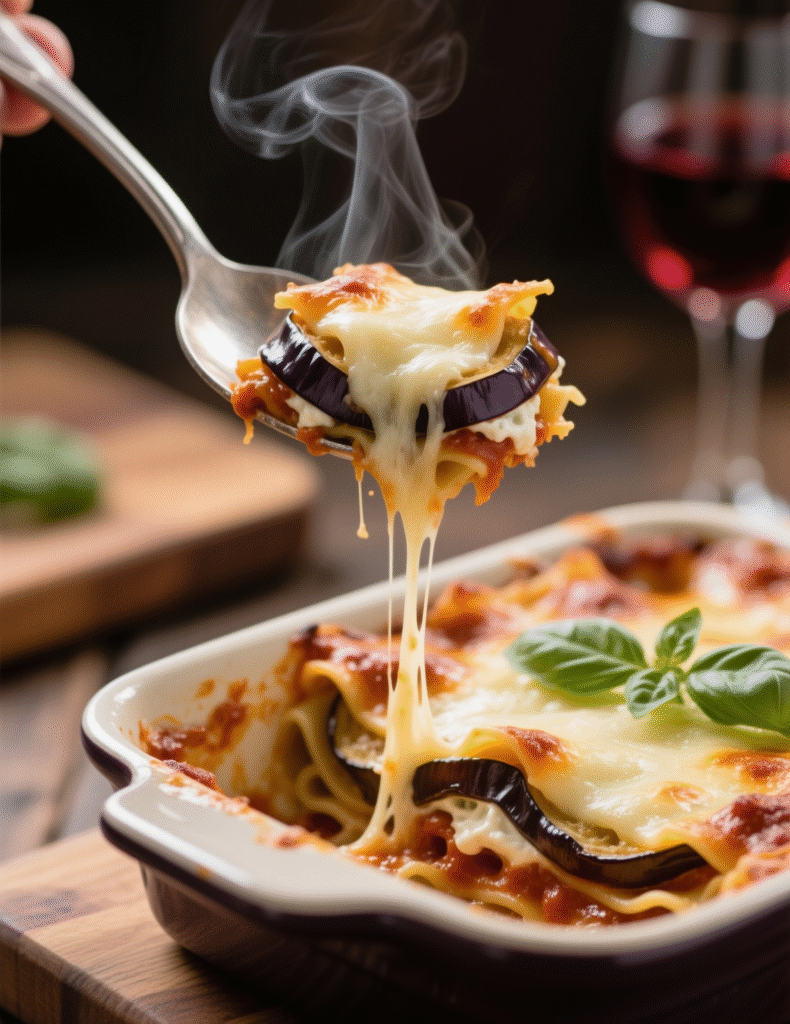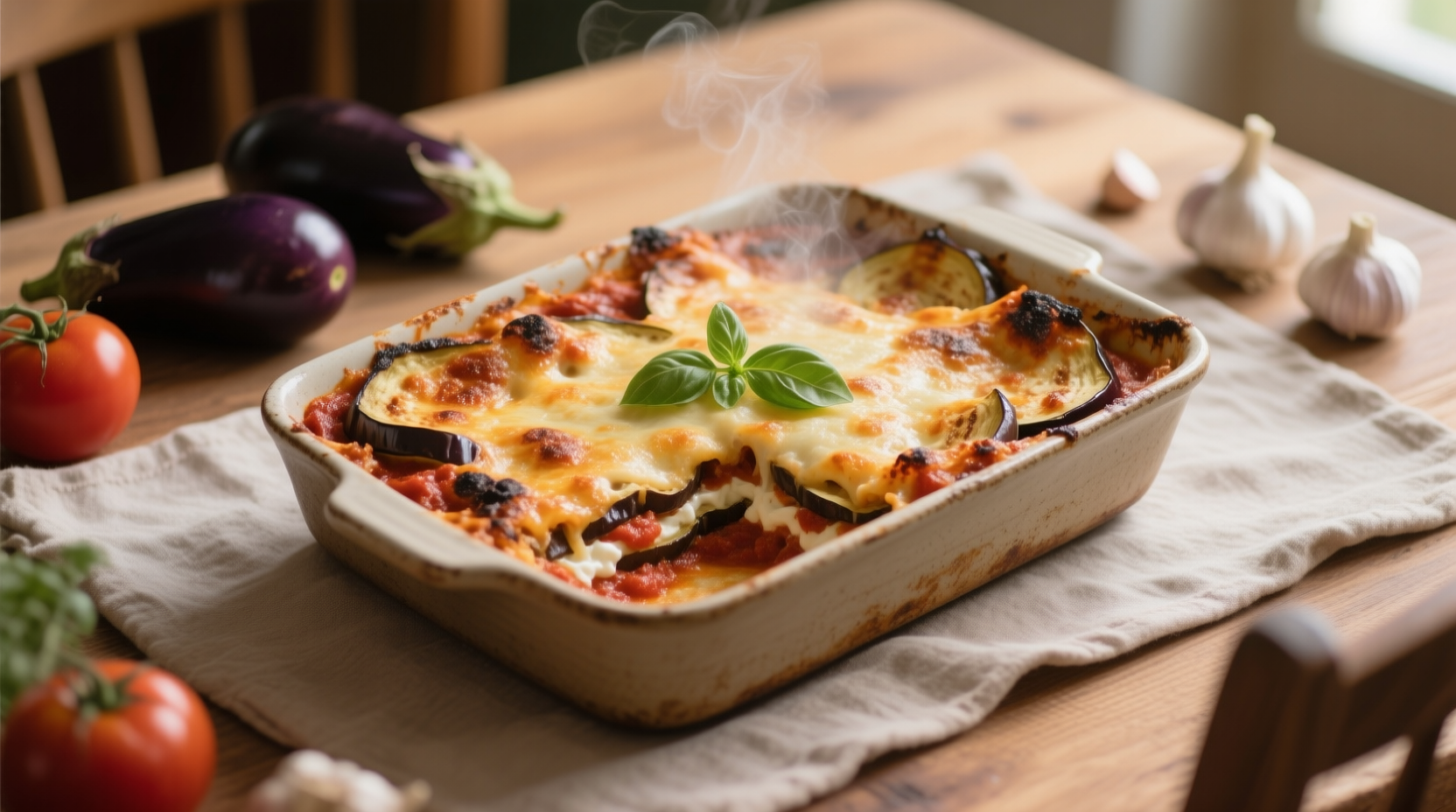There’s something oddly comforting about eggplant lasagna. No, it’s not your grandma’s lasagna stuffed with sheets of pasta and bubbling béchamel. This is different. It’s earthy, lighter, and yet—done properly—it hits the table with a flavor punch so satisfying you’ll forget the noodles ever existed. My aim here is simple: give you an expert-level breakdown of how to create an eggplant lasagna recipe that doesn’t collapse into a soggy pile, but stands tall, structured, and layered with depth.
Why Eggplant Instead of Pasta?
Eggplant has always been an ingredient that intimidates some cooks. It soaks oil like a sponge, turns rubbery if undercooked, and becomes mush if you’re not paying attention. But when you master it, eggplant turns into one of the most versatile bases in Mediterranean-inspired cuisine. In lasagna, eggplant slices act as both the structure and the soul of the dish.
The big draw is health too. You cut down heavily on carbs, slash the calories compared to pasta lasagna, and sneak in extra fiber. One cup of cooked eggplant has just about 35 calories, plus a healthy dose of manganese, potassium, and antioxidants like nasunin. That purple skin isn’t just pretty—it’s medicine.
Selecting the Right Eggplant
Not all eggplants behave the same. Large globe eggplants, the ones you see piled high in supermarkets, will work, but they often bring bitterness and too much water. Slim Italian eggplants or even Japanese varieties, with their thinner skin and sweeter flesh, tend to hold up better under high heat.
The trick is firmness. Always pick an eggplant that feels heavy for its size, with taut, glossy skin. Press it lightly; it should bounce back, not sink in. A dull, wrinkled eggplant is basically a sponge waiting to ruin your sauce layers.
Dealing with Bitterness and Water
Professional kitchens rarely skip this step: salting. Slice your eggplant into half-inch slabs, sprinkle both sides generously with salt, and let them sit on paper towels for at least 30 minutes. Moisture beads on the surface, carrying bitterness out. Wipe them dry, and you’ll see how the texture firms up.
Skipping this step is risky. Eggplant will bleed out water during baking, flooding the bottom of your dish, and suddenly you’ve got eggplant soup instead of lasagna. Some chefs argue modern varieties aren’t bitter anymore. True, but it’s not just bitterness you’re dealing with—it’s structural integrity.
Should You Fry, Roast, or Grill the Eggplant?
Here’s where opinion divides even professionals. Frying eggplant in olive oil gives it an indulgent, almost creamy texture, but it turns calorie-heavy fast. Eggplant drinks oil like it’s thirsty from a marathon. Roasting or grilling, on the other hand, caramelizes the surface and adds smokiness without drowning it in fat.
I prefer roasting at 425°F (220°C) with a light brushing of olive oil. High heat drives off water, browns the flesh, and toughens it just enough to stack without falling apart. Grill marks, if you have the patience for grilling, add a layer of flavor that makes the whole dish whisper, “summer in Tuscany.”
The Sauce: Where Depth Is Built
You can’t build eggplant lasagna on bland tomato sauce. A watery marinara straight from a jar won’t cut it. Professionals build sauces like layers of music—aromatic base, body, and high notes. Start with soffritto: onion, carrot, celery. Cook slow in olive oil until everything melts down, sweet and aromatic.
Add garlic, then crushed tomatoes or even San Marzano if you’re not cutting corners. Simmer it long enough that the water evaporates and the sauce clings to a spoon. A pinch of sugar balances acidity, but don’t overdo it. Basil or oregano? That depends if you want freshness or something deeper and woodier. Personally, I layer fresh basil at the end so it doesn’t lose its soul.

Cheese Choices: Ricotta, Mozzarella, Parmigiano
Ricotta gives the creamy body. Mozzarella gives the pull. Parmigiano-Reggiano (or Grana Padano if budget presses) gives the bite. A mixture of the three creates balance.
But technique matters. Ricotta should be strained, otherwise it leaches water during baking. Mix it with an egg and Parmigiano—it binds and prevents run-off. Fresh mozzarella is amazing but also watery; professionals often slice and dry it on towels for 20 minutes before use. Skipping these little drying steps is why many home versions collapse into liquid puddles.
Layering Like an Architect
Think construction, not chaos. Start with a thin spread of tomato sauce at the bottom to prevent sticking. Then eggplant slices, overlapping slightly like roof tiles. Next, dollops of ricotta mix, a thin ladle of sauce, a sprinkle of mozzarella, and a dusting of Parmigiano.
Repeat. The goal isn’t thick layers, but balanced ones. Too much ricotta in one layer makes the whole bite feel heavy. Too much sauce drowns the eggplant. Professionals often finish with eggplant on top, covered with sauce and cheese, so the top caramelizes beautifully under high heat.
Baking: Temperature and Timing
Eggplant lasagna is unforgiving if baked wrong. Too hot and the cheese burns before the center heats. Too low and it becomes soggy. The sweet spot is 375°F (190°C), uncovered for about 30 minutes, then a quick broil at the end for that golden bubbling crust.
Let it rest. I can’t emphasize this enough. Cut into it too soon, and everything slides apart. Ten to fifteen minutes of rest allows cheese to set, juices to settle, and layers to firm up. A lasagna slice should stand tall on the plate, not collapse sideways like a drunk tower.
Variations and Professional Twists
Some chefs fold roasted red peppers between layers for smoky sweetness. Others slip in sautéed spinach or kale for an earthy punch. A bold move is béchamel instead of ricotta—a nod to the Italian north. White sauce over eggplant layers makes the dish silkier, though heavier.
Vegan professionals lean on cashew ricotta, nutritional yeast for nutty flavor, and even tofu-based fillings. Eggplant lasagna adapts well, which is why it’s a star in plant-forward fine dining.
Nutritional Edge
Replacing pasta with eggplant lowers carbs dramatically. A traditional lasagna slice can push 40-50 grams of carbs, but an eggplant version lands closer to 15-20. For gluten-free eaters, it’s not just substitution—it’s salvation. Add lean ground turkey or lentils for protein, and suddenly you’ve got a dish that’s indulgent but still weeknight-healthy.
Common Mistakes to Avoid
Slicing eggplant too thin makes it collapse. Cutting it too thick leaves rubbery centers. Half an inch is the golden number.
Over-saucing is another killer. Remember, eggplant holds less structure than pasta, so too much liquid tips it into soup territory.
And here’s the subtle one: seasoning every layer. Eggplant on its own is mild. Without salt and pepper across the ricotta mix, sauce, and even the eggplant itself, you’ll end up with something flat no matter how much cheese you sprinkle.

Eggplant Lasagna in Culinary Trends
Eggplant lasagna isn’t just a home kitchen experiment anymore. In fine dining, it’s appearing as a layered terrine with thin eggplant sheets wrapped around vegetable purées. Michelin-level chefs deconstruct it into eggplant chips stacked with tomato confit and foamed ricotta.
Meanwhile, in health-driven restaurants, keto and paleo menus feature eggplant lasagna as a star dish. Its adaptability to dietary trends has given it a second life beyond the family dinner table.
Example Recipe (Professional Version)
- 3 medium Italian eggplants
- 2 tbsp kosher salt
- 4 tbsp olive oil
- 1 onion, finely diced
- 1 carrot, finely diced
- 1 celery stalk, finely diced
- 3 garlic cloves, minced
- 2 cans San Marzano tomatoes (28 oz each)
- 1 tsp sugar
- Fresh basil, handful
- 2 cups ricotta (strained)
- 1 egg
- 1 cup grated Parmigiano-Reggiano
- 2 cups mozzarella, sliced and drained
- Black pepper to taste
Process: Salt eggplant slices, let stand 30 minutes, pat dry. Roast at 425°F until golden. Build sauce with soffritto, tomatoes, garlic, basil, and simmer. Mix ricotta, egg, Parmigiano, and pepper. Layer as described earlier. Bake at 375°F for 30-35 minutes, broil at end, rest 10 minutes before slicing.
Closing Thoughts
Eggplant lasagna is more than a pasta substitute—it’s its own category of culinary art. Done wrong, it’s heavy, soggy, and disappointing. Done right, it’s elegant, structured, and deeply flavorful.
The key takeaways are simple but crucial: salt and dry the eggplant, roast or grill for structure, reduce your sauce for depth, strain your cheese, and build layers like an architect, not a painter.
Whether you’re cooking in a home kitchen or plating for guests in a fine dining setting, eggplant lasagna deserves precision. Approach it not as a compromise but as a challenge—and you’ll create a dish that stands shoulder to shoulder with the pasta-based original, maybe even surpasses it.
FAQs
How do I prevent eggplant lasagna from getting watery?
Salt, dry, and roast the eggplant before layering to remove excess moisture.
What type of eggplant works best for lasagna?
Italian or Japanese eggplants hold structure better and taste sweeter than large globe ones.
Do I need to peel the eggplant for lasagna?
No, the skin adds flavor, nutrients, and helps slices stay intact.
Can I fry the eggplant instead of roasting it?
Yes, but it absorbs a lot of oil, making the dish heavier and higher in calories.
Should I use fresh mozzarella or shredded mozzarella?
Fresh is tastier, but it must be dried before use; shredded is easier and less watery.
How thick should eggplant slices be for lasagna?
About half an inch thick for the best texture and layering stability.
Can eggplant lasagna be made ahead of time?
Yes, assemble in advance and bake later, or bake and reheat within two days.
Is eggplant lasagna gluten-free?
Yes, since eggplant replaces pasta, it’s naturally gluten-free.
Can I make eggplant lasagna without ricotta?
Absolutely, use béchamel, cashew cream, or another creamy substitute.
What wine pairs well with eggplant lasagna?
A medium-bodied red like Chianti or Sangiovese complements it beautifully.

Mariana is a passionate home cook who creates delicious, easy-to-follow recipes for busy people. From energizing breakfasts to satisfying dinners and indulgent desserts, her dishes are designed to fuel both your body and hustle.
When she’s not in the kitchen, she’s exploring new flavors and dreaming up her next recipe to share with the Foodie Hustle community.

